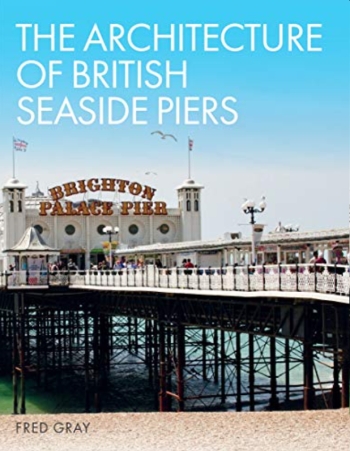The Architecture of British Seaside Piers

|
| The Architecture of British Seaside Piers, Fred Gray, Crowood Press, 2020, 197 colour and 123 black and white illustrations, hardback. |
Piers are structures that define the British seaside. Derived from stone breakwaters and jetties, the first piers gave early 19th-century visitors, who came to seaside towns to enjoy the purity of the sea air and drink seawater for its medicinal qualities, another way to consume nature: it allowed them to walk on water. Ryde, Brighton and Herne Bay were among the earliest piers built on timber piles with timber decks.
In the second half of the century, with the growth of railways, the seaside became accessible to the masses. Between 1860 and 1901, 77 new piers were built in these newly popular towns. Timber was largely replaced by a mixture of cast and wrought iron, as structures became increasingly daring and long, accommodating a range of buildings offering entertainment. They proved hugely popular: when Blackpool pier was completed in 1863, 20,000 people attended the opening, whereas the population of the town was only four thousand.
But there is an inherent problem with piers: with their feet in salt water and being buffeted by waves, they are high maintenance and expensive to keep. Timber decays, iron rusts and the sea itself can destroy in a single storm. The 20th century saw the decline of many piers. Some suffered during the second world war: Southend, Plymouth Hoe and Margate were bombed, and Brighton West, Clacton and Eastbourne were damaged in explosions of drifting mines.
After the war, piers suffered economically as commercial flights took visitors away from British seaside towns. While the towns quietly stagnated, piers actively decayed. The inevitable started to happen. Cowes pier was dismantled in 1961. When Morecombe pier was wrecked by a storm in 1977, it was demolished, as were Hunstanton and Herne Bay. Many succumbed to fire, most famously, Eugenius Birch’s masterpiece, West Brighton Pier, in 2003.
One great success story, though, is Clevedon Pier, which John Betjeman thought was ‘the most beautiful pier in England’. Following the partial collapse of its wrought-iron structure in 1970, a building preservation trust was formed and, drawing on funding from English Heritage and the National Heritage Memorial Fund, the pier was fully repaired. Revived in the original form of a walkway over water, the pier is exquisitely elegant.
An unexpected new audience has been brought to the pier too: with One Direction filming their video You and I there, it has become the Abbey Road to a new generation. I am guessing, though, that the author of this book, Fred Gray, does not have a teenage daughter, because in this fact-filled book, full of interesting old photos and drawings and displaying a clear understanding of the technology of piers, the One Direction effect on the popularity of Clevedon is not mentioned.
This article originally appeared as ‘In a seaward direction’ in Context 168, published by the Institute of Historic Building Conservation (IHBC) in June 2021. It was written by Kate Judge, architectural historian.
--Institute of Historic Building Conservation
Related articles on Designing Buildings
- Coastal defences.
- Conservation.
- Conserving Cornish harbours.
- England's seaside heritage from the air.
- Future of seaside towns.
- Heritage coast.
- IHBC articles.
- Jetty.
- Lighthouse.
- Pier.
- Seashaken Houses: A lighthouse history from Eddystone to Fastnet.
- The Institute of Historic Building Conservation.
- Waterfronts Revisited: European ports in a historic and global perspective.
IHBC NewsBlog
Old Sarum fire in listed (& disputed) WW1 Hangar - Wiltshire Council has sought legal advice after fire engulfed a listed First World War hangar that was embroiled in a lengthy planning dispute.
UK Antarctic Heritage Trust launches ‘Virtual Visit’ website area
The Trust calls on people to 'Immerse yourself in our heritage – Making Antarctica Accessible'
Southend Council pledge to force Kursaal owners to maintain building
The Council has pledged to use ‘every tool in the toolbox’ if urgent repairs are not carried out.
HE’s Research Magazine publishes a major study of the heritage of England’s suburbs
The article traces the long evolution of an internal programme to research 200 years of suburban growth
IHBC Context 183 Wellbeing and Heritage published
The issue explores issues at the intersection of heritage and wellbeing.
SAVE celebrates 50 years of campaigning 1975-2025
SAVE Britain’s Heritage has announced events across the country to celebrate bringing new life to remarkable buildings.
IHBC Annual School 2025 - Shrewsbury 12-14 June
Themed Heritage in Context – Value: Plan: Change, join in-person or online.
200th Anniversary Celebration of the Modern Railway Planned
The Stockton & Darlington Railway opened on September 27, 1825.
Competence Framework Launched for Sustainability in the Built Environment
The Construction Industry Council (CIC) and the Edge have jointly published the framework.
Historic England Launches Wellbeing Strategy for Heritage
Whether through visiting, volunteering, learning or creative practice, engaging with heritage can strengthen confidence, resilience, hope and social connections.














